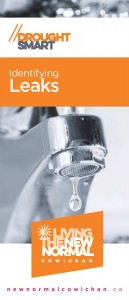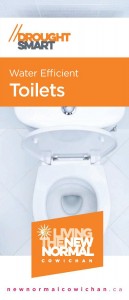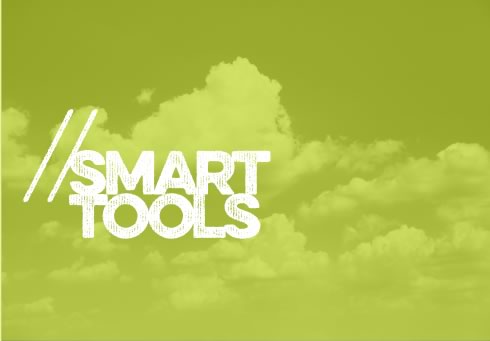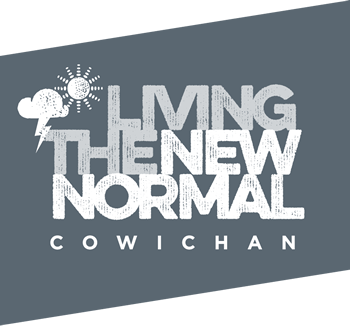Tools for Home
Water Conservation Tips
The average British Columbian uses 353 litres of fresh water every day – almost 20% more than the national average. While we may not have to worry about “running out” of water, being more efficient has some very important benefits for us all:
- more water in streams for fish and ecosystems
- healthy and abundant groundwater and aquifers
- less sewage disposed in the environment
- reduced energy use and greenhouse gas emissions
- lower costs for providing water services
- deferring the need for expensive water treatment up- grades or new water sources
Water conservation starts with understanding how water gets used and doing the same with less. The tips below can help you to make small adjustments to how you do things:

Become a water detective and sniff out these worst offenders for wasting water.
Leaky toilets or toilets that run after flushing can waste thousands of litres per year. Test for leaks using a small amount of food colouring or a dye tablet and fix leaks and running toilets immediately. Free dye tablets are available for pick-up at the CVRD office (175 Ingram Street in Duncan).
Leaky faucets and showerheads waste an equally huge amount of water. Most water leaks can be repaired using inexpensive washers available at your local hardware store. Consider switching to a low flow showerhead. They are relatively inexpensive and easy to install. Free flow rate bags to measure the flow of faucets and showerheads are available for pick-up at the CVRD office (175 Ingram Street in Duncan).
Toilets that use 13 to 20 litres per flush are water hogs. Replace your old model toilets with high efficiency toilets (3 to 6 litres per flush). Electoral area residents are eligible for a $75 low flush toilet rebate program (application form).
Top loading laundry machines are inefficient and can use up to 3 times as much water as front loading machines. The next time you buy a washer, make water efficiency a top priority.
In your home
Bathroom
- Shortening your shower by 2 minutes can save about 40 litres of water.
- Using the toilet as a wastebasket is a bad idea. Every time you flush a facial tissue or other small bit of trash, you waste up to 13 liters of water.
- Install water aerators on your faucets. Aerators dramatically reduce water use by mixing it with air.
- Turning off the water after you’ve wet your toothbrush can save 10 litres.
Kitchen
- Run your dishwasher only when it is full, using the most efficient energy and water settings.
- When washing dishes by hand, don’t let the water run. Fill one sink with wash water and the other with rinse water. If you only have one sink, you can use a basin or large pot of water for rinsing.
- Scrape dishes instead of rinsing them under running water before loading your dishwasher.
- Don’t let the faucet run while you clean fruit or vegetables. Instead rinse them in a sink with a stopper or in a pan of clean water.
- Install water saving aerators on your kitchen faucet.
- Check out these tips for conserving water while you rinse your recyclables
In your yard
Outdoor use accounts for the majority of our summer water use, mainly for watering lawns and gardens.
Lawns
- Let your lawn go dormant in the summer. A brown lawn is not a dead lawn, and it will go green again when the rains return in the fall.
- Convert part or all of your yard to native plant species which require much less water than a lawn.
- Make your watering more efficient.
- Water deeply and infrequently to promote deep, healthy roots. Once a week is enough. Overwatering or frequent, shallow watering, can weaken your lawn.
- Raise your mower blades – longer grass (3 inches is ideal) shades the soil and prevents evaporation.
- Aerate your lawn, top-dress with compost, and use the mulch feature on your mower to improve water retention.
- Water in the early morning or late evening to reduce water loss from evaporation. If you have a timer, you can set it to run during the night.
- Maintain your irrigation system. Leaks or broken sprinkler heads waste water.
Gardens
- Mulch around trees, shrubs, and other plants to retain water in the soil. Adding compost to the soil helps maintain soil moisture.
- Water in the early morning or late evening to reduce water loss from evaporation.
- Hand water or install a drip irrigation system so that water only goes to the areas that need it. Avoid watering paths, patios, or driveways.
- Consider a rainwater collection system (even a simple rainbarrel) to save water for the dry season. Re-use water (e.g. old water from water jugs, pet dishes, kids pools) for watering plants rather than dumping it out.
Other
- Sweep your driveway rather than spraying it clean with a hose or pressure washer.
- A dirty car shows that you’re serious about saving water. There’s no road salt or brine to corrode your car during the summer, so weekly washing is not necessary. Commercial car washes are another option that often use less water than washing at home.
Explore some useful tools to help you calculate and reduce your household water use.
Estimating your household water use
What is domestic water use?
Water used for household purposes, such as drinking, food preparation, bathing, washing clothes, dishes, and dogs, flushing toilets, and watering lawns and gardens.
How to estimate your household domestic water use?
The Cowichan Water Challenge website has a home water use calculator to give you an idea of how much water your household uses per year. You can divide by the number of members of your household to estimate your personal domestic water use.
Compare yourself to the following benchmarks (averages):
- BC: 128 cubic meters per person per year
- Canada: 99 cubic meters per person per year
- Germany: 70 cubic meters per person per year
- UK: 54 cubic meters per person per year
Other water use calculators
- CBC individual water use calculator
- Water Footprint Network’s Extended Calculator
How does a water footprint differ from water use?
Water footprints include domestic water use and fresh water that is used to produce goods and services consumed: agricultural, industrial and professional. Freshwater that is used to produce goods and services has two components: the part of the footprint that falls inside the country (internal water footprint) and the part of the footprint that is due to consumption of goods and services originating from other countries in the world (external water footprint).
Sources
- Living Water Smart
- Mekonnen, M.M. and Hoekstra, A.Y. (2011) National water footprint accounts: the green, blue and grey water footprint of production and consumption, Value of Water Research Report Series No. 50, UNESCO-IHE, Delft, the Netherlands.
- UN Human Development Reports: http://hdr.undp.org/en/media/HDR06-complete.pdf














